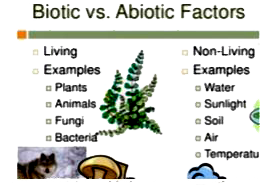The path that an element takes as it moves from abiotic systems through living organisms and back again is referred to as its
biogeochemical cycle
biological cycle
nutrient cycle
geochemical cycle
The correct Answer is:A
Step-by-Step Solution:
1. Understanding the Question: The question asks about the path that an element takes as it moves from abiotic systems (non-living components of the environment) through living organisms and back again.
2. Identifying Key Terms: The key terms here are "abiotic systems," "living organisms," and the concept of a "path" that the element follows.
3. Defining the Concept: The path described in the question is a cycle that involves both abiotic (like air, water, and minerals) and biotic (living organisms) components.
4. Recognizing the Correct Term: The term that describes this cyclical movement of elements through the environment and living organisms is known as the "biogeochemical cycle."
5. Explaining Biogeochemical Cycles: Biogeochemical cycles include various cycles such as the carbon cycle, nitrogen cycle, oxygen cycle, and hydrologic cycle. These cycles illustrate how elements are exchanged between the living (biotic) and non-living (abiotic) components of the ecosystem.
6. Eliminating Incorrect Options: Other options like "biological cycle," "nutrient cycle," and "geochemical cycle" do not encompass the complete movement of elements through both biotic and abiotic systems, making them incorrect.
7. Final Answer: Therefore, the correct answer to the question is "biogeochemical cycle."
---
Similar Questions
Biosphere is a global ecosystem composed of living organisms and abiotic factors from which they derive energy and nutrients. And ecosystem is defined as structural and functional unit of the biosphere comprising of living and non-living environment that interact by means of food chains and chemical cycles resulting in energy flow, biotic diversity and material cycling to form a stable, self-supporting system

Which of the following group of organisms are not included in ecological food chain?
View SolutionBiosphere is a global ecosystem composed of living organisms and abiotic factors from which they derive energy and nutrients. And ecosystem is defined as structural and functional unit of the biosphere comprising of living and non-living environment that interact by means of food chains and chemical cycles resulting in energy flow, biotic diversity and material cycling to form a stable, self-supporting system

The diagram below shows a food web from the sea shore

The mussel can be described as
View Solution
Knowledge Check
The process through which a living organism produces more of its own kind is called ____
ASpeciesBReproductionCFertilizationDAdolescenceIt is said that elemental composition of living organisms and that of inanimate objects (like earth's crust ) are similar in the sense that all the major elements are present in both. Then what would be the difference between these two groups ?
Choose a correct answer from the following.ALiving organisms have more gold in them than inanimate objects.BLiving organisms have more water in their body than inanimate objects.CLiving organisms have more carbon, oxygen and hydrogen per unit mass than inanimate objects.DLiving organisms have more calcium in them than inanimate objects.Use the following information to answer question.
A student is conducting an experiment using a ball that is attached to the end of a string on a pendulum. The student pulls the ball back so that it is at an angle to its resting position. As the student releases the ball, it swings forward and backward. The student measures the time it takes the ball to make one complete period. A period is defined as the time it takes the ball to swing forward and back again to its starting position. This is repeated using different string lengths.
You must make the student locate an appropriate control variable for this experiment? It is theAThe periodBThe length of the stringCThe mass of the ballDThe color of the ball
Biosphere is a global ecosystem composed of living organisms and abiotic factors from which they derive energy and nutrients. And ecosystem is defined as structural and functional unit of the biosphere comprising of living and non-living environment that interact by means of food chains and chemical cycles resulting in energy flow, biotic diversity and material cycling to form a stable, self-supporting system

The given figure best represents:

View SolutionBiosphere is a global ecosystem composed of living organisms and abiotic factors from which they derive energy and nutrients. And ecosystem is defined as structural and functional unit of the biosphere comprising of living and non-living environment that interact by means of food chains and chemical cycles resulting in energy flow, biotic diversity and material cycling to form a stable, self-supporting system

Which trophic level is incorrectly defined?
View SolutionA system undregoes a change of state during which 100kJ of heat is transferred to it and it does 50kJ of work. The system is brought back to its original state through a process during which 120kJ of heat is transferred to it. Find the work done by the system in the second process.
View SolutionAssertion. Living system are closed systems.
Reason. Energy of living organisms cannot be lost of gained from environment
View SolutionA particle moves on a path as shown. The particle takes 10 seconds in going from starting point to the final point. What is the average velocity vector of the particle ?

View Solution
